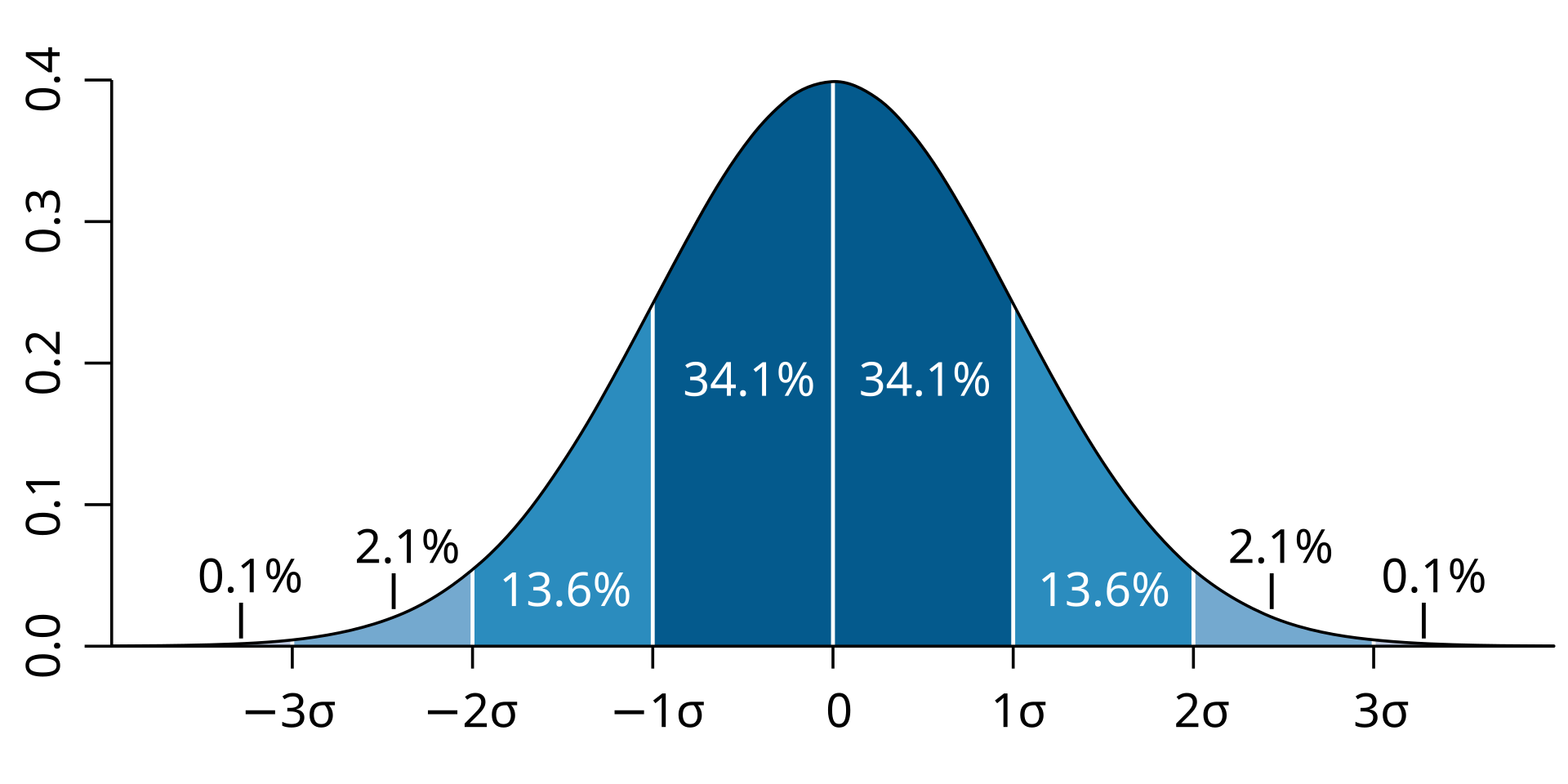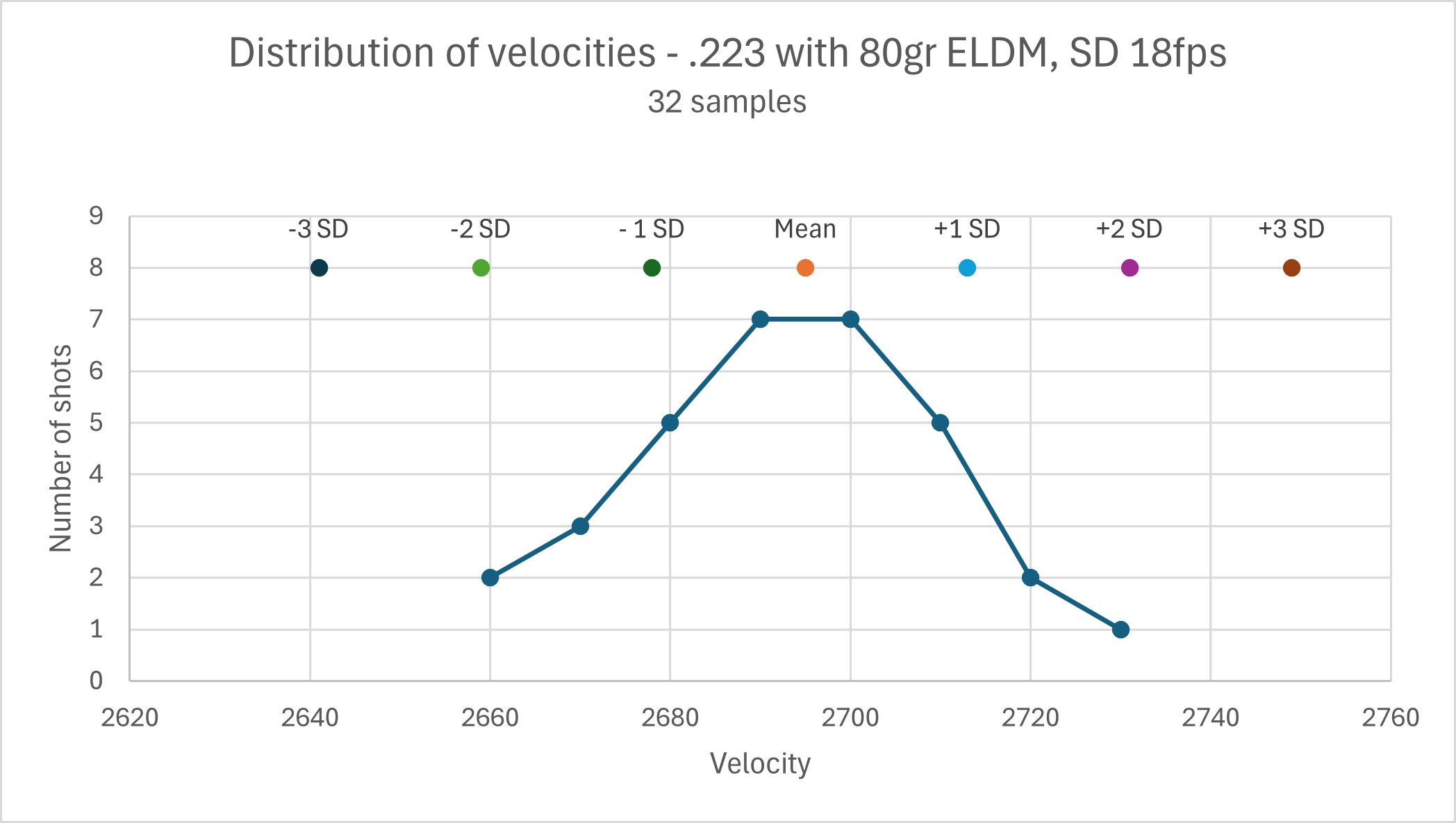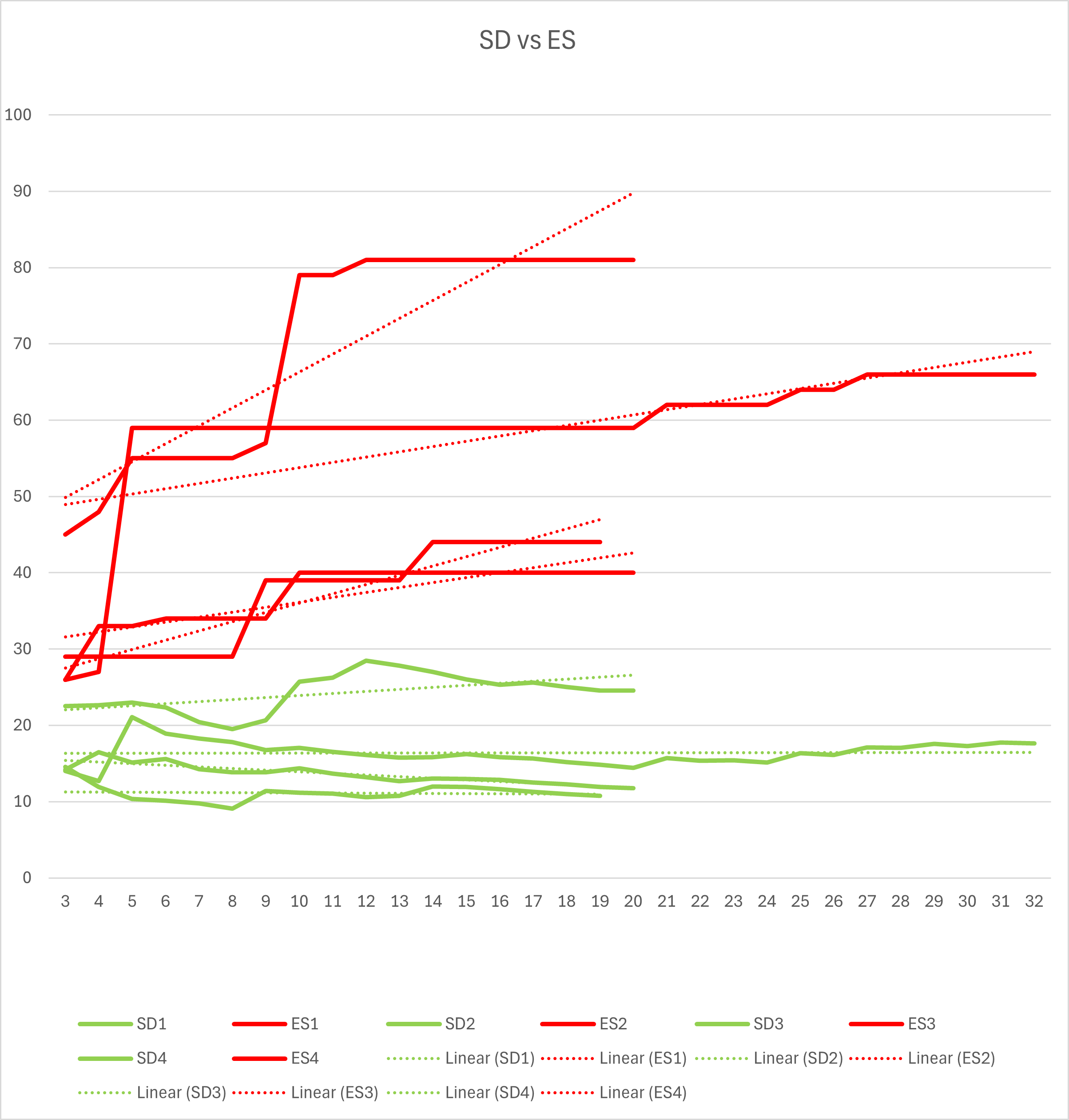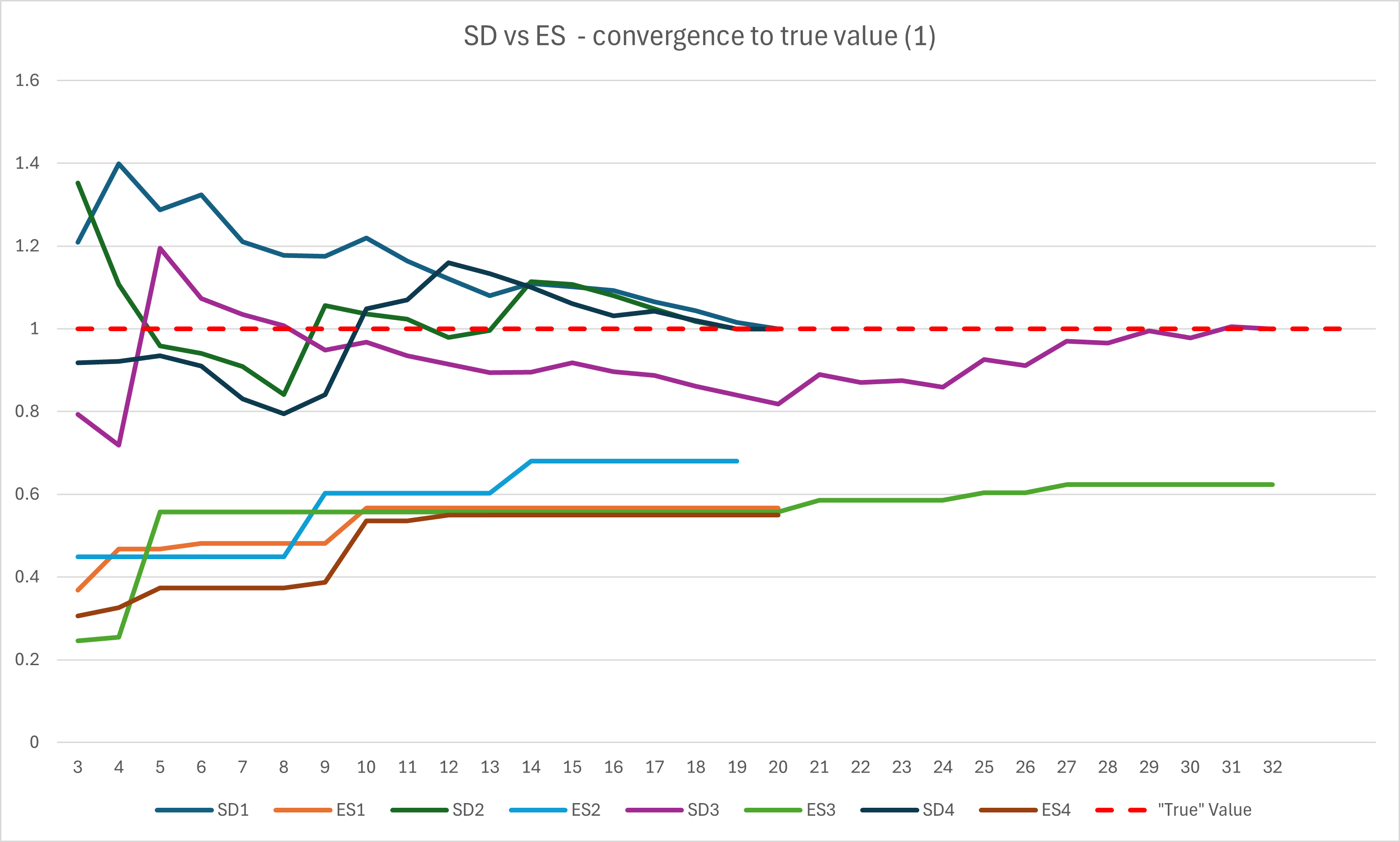The extreme spread (ES) of velocity is a metric that is often referred to by shooters, and particularly handloaders. As a measure, it is a poor choice of a tool for the purposes for which it is used, particularly when derived from a small number of shots. The Standard Deviation (SD) of the velocity is a superior measure for practical use. A reasonable sample size is required to have confidence in the value of either metric.
Definitions:
ES as I am using it, refers to the difference between the highest and lowest velocity measured from a particular load from a particular rifle. This may be measured from a single string of any number of shots, or as an aggregate over multiple strings of shots. The assumption is that a low ES indicates a consistent velocity from the load/rifle combination.
SD is a measure of the variation of the numbers in a population around the average - a low SD indicates low variation in the population. In a population where values follow a normal distribution, 68.2% of samples will have a value within (+ or -) 1 standard deviation from the mean value. 95.4% of values will be within 2 standard deviations, and 99.7% will be within 3 standard deviations of the mean (see image below).
Like a lot of things in the world, velocity measurements from rifle cartridges tend to follow a pretty normal looking distribution - once you get enough samples to fill it out.
This is a graph of the distribution of 32 shots from a load/rifle combination with an SD of 18. You can see that all measured 32 shots fall within the 95% expected 2SD range - this is expected with such a small sample. Were an additional 68 shots fired to bring it up to 100 shots - a couple of shots should be expected to fall in the 2-3SD range.
What is the ES commonly used for? Frequently the ES is used as a measure of the "quality" of a load when doing load development with an "optimisation" type approach (looking for the 'best' combination of powder charge and seating depth with particular components), on the assumption that different combinations produce different results. A lower ES is assumed to indicate a more consistent load - either as a "better load" for precision, or specifically with the intent of reducing vertical spread at longer ranges.
How well does ES perform these tasks? When you measure velocities from your rifle/load combination, you are taking a sample from a population (the population of all shots that the rifle/load combination could/will ever fire before barrel wear changes velocity, etc). When looking to use the ES, you are assuming that the sample you have taken gives you an accurate enough representation of the population to be useful.
ES as a metric is limited by the fact that it always only uses 2 of however many datapoints from the sample you have taken, and you are relying on these being the values at the extreme ends of the population. The fewer data points you collect in your sample, the lower the probability that these datapoints are representative of the extreme ends of the population - in fact, the fewer data points you collect, the more likely it is that they are NOT the extreme ends - 68% of shot velocities fall pretty close to the average velocity. You are more likely to get a low ES than a high ES, regardless of the consistency of the load.
Let's look at some examples from real 10 shot strings -
Which of these 3 loads is the "best" based on the measured ES ? Well - it depends how many shots you use to measure!
This table shows the relative ranking you'd give each load based on ES at 3, 5, 10 shots - and the actual relative ranking from the SD. These are just 3 strings selected for demonstration purposes - I have thousands of shots of other data in other strings that demonstrate the same point - ES can provide a general picture of how consistent a load is when measured over a larger sample size, however, it is not reliable at 3 or 5 shot strings and will always increase, sometimes dramatically, with additional shots. Why? Because of the high probability of collecting data on shots from near the average velocity, your ES measurement is almost certainly significantly under-representing the true "extreme spread" of the velocities that can be expected from that rifle/load combination. As you fire more shots, the ES will creep upward closer to the true value.
Well, what about SD then? As this table shows, it is also a poor metric at low sample sizes, as far as making relative rankings between loads. (the real story here is that data in small samples isn't very useful, depending what you try to do with it!).
However, as you increase the sample size, the SD does not continue to increase like the ES. Rather, the value will wander slightly up and down. Because the SD uses data from every shot, every shot increases the precision of the number. The SD measurement gets closer to the "true" SD value with every shot you add, whereas the ES just gets bigger. This can be seen in the chart below - red ES numbers continue to rise with additional shots, while green SD numbers oscillate around the "true" value.
As the SD is a more efficient statistic than the ES, the SD has much lower absolute error than the ES. A calculated SD is much closer to the "true" SD than a calculated ES is to the true ES. The below chart shows this - the "True" values have been given a value of 1, and the relative correctness of each metric for 4 loads (19-32 shot strings) is plotted shot-by-shot sequentially. You can see that within 10 shots, the SD is within about 20% of the "true" SD, whereas the ES progressively climbs towards the true value - but even at 32 shots, never approaches much better than 40% error. The "true" ES can be calculated, if you wish to know it for any reason, by multiplying a reasonably accurate SD by 6 - this gives the range into which 99.7% of your velocities can be expected to fall.
So - if you want to know whether your rifle/load combination is consistent: Use the SD and take a sample of at least 10 shots.
How much should you care about how consistency of the velocity of your load? That's another bonus of using the standard deviation. Using a variety of calculators, the SD can be used (with other inputs) to calculate hit probability. Hit probability dictates your requirements - i.e. what level of consistency, precision, etc, you require for your use.
Using the example of a .284 winchester with a 1.5-2MOA precision (about .1MRAD mean radius) with a 162 ELDM at 2700 fps, and a 200mm dia circle target at 500m:
a 5fps SD gives a 96% hit probability
a 10fps SD gives a 95% hit probability
a 20fps SD gives a 90% hit probability
a 30 fps SD gives a 82% hit probability
This hit probability is based on the random error in the mechanical system and does not account for shooter errors, wind call error, zero offset, etc - shooter proficiency errors swamp the small effects of SD at this range and closer. At 400m, all the above SD values are greater than 95% hit probability. If you are a close range hunter, velocity consistency tells you nothing useful about the real-world performance of your load.
If you are a precision shooter or a longer-range hunter, you may need to care more. However, there is little evidence available that you can do anything to meaningfully change the consistency of your velocity once you have selected components - the evidence currently available seems to be that if you start with a fit-for-purpose cartridge, quality components and a good process using quality equipment, you're likely to get a consistent enough velocity regardless of any other attempts at "tuning". There is certainly no point trying to tune anything based on 3-5 shot testing as shown above.
Welcome guest, is this your first visit? Create Account now to join.
Welcome to the NZ Hunting and Shooting Forums.
Search Forums
User Tag List
Results 16 to 18 of 18
Threaded View
-
09-01-2025, 01:15 PM #1
Let's talk about velocity Extreme Spread (ES)
Similar Threads
-
Adding to the spread
By Rock river arms hunter in forum Game Bird HuntingReplies: 2Last Post: 24-03-2017, 01:27 PM -
"Extreme Velocity Spread"!
By Remington 5R .300 Win Mag in forum Reloading and BallisticsReplies: 60Last Post: 28-10-2013, 09:43 PM -
Extreme spread
By R93 in forum Reloading and BallisticsReplies: 4Last Post: 01-07-2012, 07:46 PM -
Getting movment into your pond decoy spread
By Baz in forum Game Bird HuntingReplies: 10Last Post: 11-04-2012, 11:33 PM -
Welcome & Spread the word that there's a new forum in town
By Philipo in forum IntroductionsReplies: 14Last Post: 25-12-2011, 12:48 AM
Tags for this Thread
Welcome to NZ Hunting and Shooting Forums! We see you're new here, or arn't logged in. Create an account, and Login for full access including our FREE BUY and SELL section Register NOW!!




 25Likes
25Likes LinkBack URL
LinkBack URL About LinkBacks
About LinkBacks











 Reply With Quote
Reply With Quote


Bookmarks